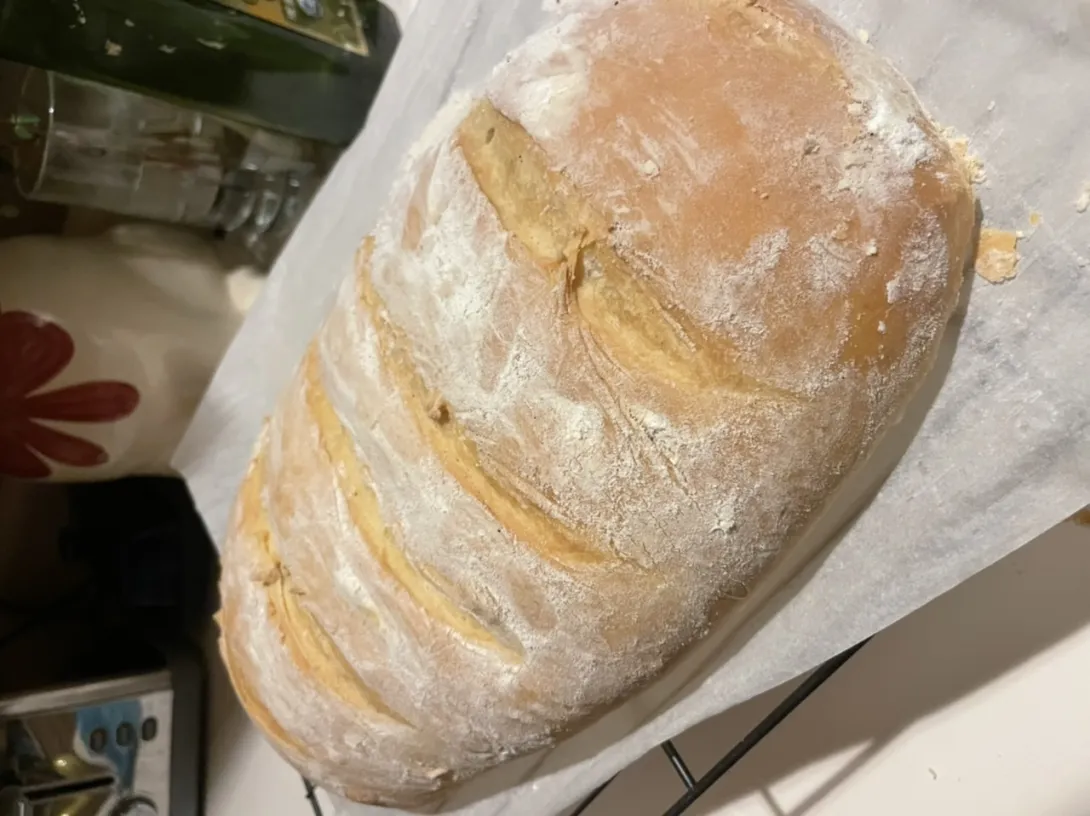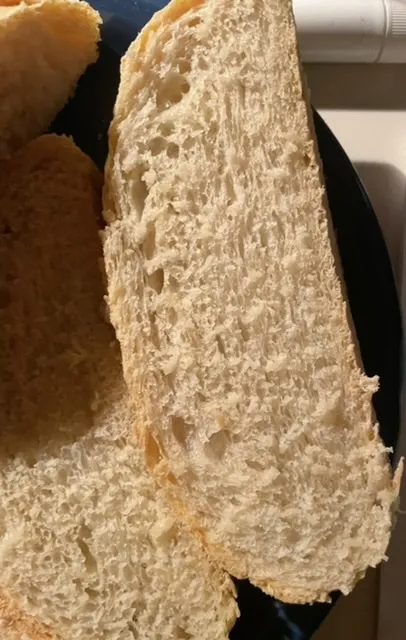Hi there! I’m a relatively new baker, only really becoming serious over the last few years. I tried a new recipe—Paul Hollywood’s Bloomer Bread—and it didn’t quite turn out.
https://www.waitrose.com/content/waitrose/en/home/recipes/recipe_directory/p/paul-hollywood-swhitebloomerbread.html
He says to use olive oil to knead the loaf as it is quite sticky. I’m not sure if I used too much water to combine the ingredients; it was so sticky I could barely work with it. I kept using more olive oil and I’m not sure if it contributed to the flatness of my loaf. I also used yeast that might have been past date (7/21 when it’s 12/21). I think the most probable cause is issues with the prove itself. I’m attaching pictures.
Though I baked it past the recommended time, the crust never fully developed that crispness and I found it to be far too crumbly inside and it almost looks bunched towards the bottom of the loaf. If someone could take a look and give me some advice on my mistake, I would really appreciate it. I love making bread and have had some amazing loafs; this wasn’t one.
Thank You!!!


Oil interferes with gluten development.
I skimmed the recipe quickly (may have missed something). He mentioned using a small amount of oil to slick the kneading surface which is not the same as kneading oil into the bread.
Another option for wet doughs is to keep your hands wet, use a scraper, and use more cycles of flattening it out and folding to develop the gluten. Even a wet dough will come together that way.
EDIT: clearly I misread recipe in my quick skim. Sorry.
Thank you for your tips! Man it was so sticky. I used a bench scraper repeatedly, but it was so sticky, I couldn’t properly knead it. The oil was a nightmare. It just didn’t seem to come together without it, though. Do you think I had it too wet? Or should I just have kept going? I really liked the flavor of the bread and want to get it right. I will definitely use less oil and keep my hands wet.
What flour did you use? At the specified 64% hydration strong bread flour shouldn't be that sticky to be honest. Is it possible you made a mistake when measuring out ingredients?
If you are sure you did everything right and that was the result, try reducing the water a little next time...
You and your fellow commenters have just taught me about hydration percentages. I didn’t know this! I used a scale while measuring and was exact on the measurements. I think you guys are right; I added too much water to begin with. Some have suggested I add some of the remaining water and let it rest before deciding it needs more. Like I said before, I’m so new I don’t quite have the feel/sight for when things are as they should be. I am learning so much from you all!
1. Tip the flour into a large mixing bowl and add the salt to one side of the bowl and the yeast to the other. Add the oil and 240ml of the water. Use the fingers of one hand to mix the ingredients together. Add the remaining water a little at a time until you have a soft, sticky dough and all the flour is incorporated. You may not need all the water.
After adding the 240ml and begin adding the rest of the water may I suggest you add 20-60g at first. Just until the dough comes together. Should be tacky but not sticky. Then cover and rest for 20 minutes. Give it time to absorb the liquid. You can always adjust up if needed after the rest. Also make sure you're using strong bread flour. 13% protein or higher.
While technically oil does not contribute to the hydration it will contribute to how the dough feels. So for an all white bread flour 60% hydration is a nice average for a dough that handles well. Shouldn't be too sticky. If you have 500g flour then 300g water will be 60% hydration. When first forming the dough you add 240ml/g water + 3 tablespoons oil (about 40g). This gives you and extra 60g water to make it a real 60% hydrated dough but only 20g for the feel of a 60% hydration dough.
I'm also thinking perhaps the oil should be added later! Form the dough initially at 60% hydration - 500g flour + 300g water - then allow it to rest for 20 minutes. After which add oil. This should make it easier to handle.
Also it is an enriched dough so it might need more time!
I never considered hydration percentages! I’ve always simply weighed and measured. Wow! A ratio of liquid to dry? This is fascinating! Do you really find certain hydration percentages associated wit’s specific dough? Some are wetter or drier? want to learn more about this!
I am definitely using strong bread flour. I am sure there are a thousand varieties of bread flours, but I’m just using the one labeled bread flour by King Arthur. Is there a better brand to work with?
I’ll try adding oil after resting. Can the oil retard the yeast? Clearly I used far too much originally.
Wondering if you may have used a very weak flour. Even with a little oil, 64% hydration shouldn’t be extremely sticky with a strong flour.
I’ve been using King Arthur bread flour as that is what my local shop carries. Do you have any suggestions as to a better flour to use? My mind is completely blown about these hydration percentages. I did ultimately add the entirety of the water. I think I’ll try adding the initial amount as suggested by another commenter and allow it to rest before adding more? I don’t have the skill yet to judge whether something is the correct consistency. You all have been unbelievably helpful! I am so glad I found this website! No one I know enjoys bread making, so I can’t discuss these specific issues with anyone! You all are amazing and I am so grateful for your help!
King Arthur bread flour is fine. No problems there. Unless to added a lot of oil my thought is now, you made an error measuring water or flour.
8.2% oil. I wouldn’t think the dough would be sticky. I’d think oil makes a dough non-sticky. Maybe you could cut the oil back to 4%.
If you try the bake again let us know how it turns out.
I plan on trying again this week. I will definitely measure all my ingredients and triple check. I’ll keep notes on how much the finals will be and let you guys know.
It is easy to overdose the water when mixing up dough, one tablespoon of water can make a big difference so try not to randomly dump water into what looks like a too dry flour mixture. After adding most of the water, stick a soup spoon into the rest and add a tablespoon at a time while working in water with one hand. You can get a better feel for the dough as it forms. This will also apply as you get better with this recipe. When adding extra water, more than the recipe, one tablespoon at a time and just into the dry flour spots. Work in before adding more. :)
Oil on the counter top is easy to control. Pour about half a teaspoon of oil into the palm of one hand. Now smear the oil on both your hands to coat them lightly (make a slight pause for your hands to say, "Aaaaah, that feels so good!") and then wipe them off onto the designated countertop spot where you plan to work. A spot about as big as a large pizza. You get lightly coated hands & working surface. Use less and less as your weekly experience with this dough progresses. You may find yourself not needing any oil later on.
I will definitely continue this recipe and take lots of notes. I really enjoyed the flavor of it. Nice basic white loaf. My husband went nuts over it even though I told him it wasn’t right. This is why I am thrilled I found this website and can discuss bread with people who know! People here are so generous with their knowledge and experience!
Pretty easy. Dig out your calculator and play with the numbers. (By the way a tablespoon or soupspoon is about 15g.). First look at the recipe and add up the water amounts and flour amounts separately Then take the total water and divide by the total flour. Now multipy by 100 and the result is in%.
Ex. 300g water divided by 500g flour gives 0,6 That times 100 gives 60. So 60% hydration
I get the percentages, but can you explain more the significance of hydration in baking? Different loaves will have different hydration levels that change textures, flavors, etc?
Maurizio usually has good answers. Here is a sample related to your issues:
https://www.kingarthurbaking.com/blog/2020/11/05/producing-an-open-crumb-in-sourdough-bread
Also worth getting a fresh supply of yeast. I wouldn't be happy using out of date yeast unless it had been stored in the freezer.
In fact it's best to store newly purchased yeast in the freezer even if it hasn't been opened.
Lance
I will get new yeast for sure. I’ve started a notebook now and will catalog everything for this recipe. I can’t wait to try again and share my results.
In a bowl mix the flour and yeast.
Make a well in the flour.
Add the salt to the well and then pour in the water.
Mix and form the dough.
Knead for 2-3 minutes and then add the oil.
Incorporate the oil by folding and squeezing the dough, it'll begin to come apart but then form again, and then carry on kneading till full gluten formation about 8-10 minutes. If you think the dough needs more water you can add a little at a time till it feels right.
Place the bowl in a plastic bag and rest till the dough has doubled.
De-gas the dough and shape.
Final proof for 40 minutes and then bake in a pre-heated oven.
A couple points:
To get the most out of instant yeast, mix it into the water first rather than the flour. This dissolves each particle and makes the yeast cells more available to surroundings. I do this with fresh yeast but it's even more important with old yeast: the "outer cells" of each particle are the ones that get the oxidative damage first and go inactive. If you don't dissolve those outer dead cells, they can "shield" the inner ones from mixing with the dough properly. It's only an issue if your yeast is old.
Your flour could also be old. I've also had very sticky doughs from the "20% off" bags. If you live in a more humid area (I do), ambient water moisture can activate the amylase over time. This breaks down the starch and leaves sugars readily available in the flour. Too many sugars and not enough starch will make gluten formation/kneading difficult. If you have ever added straight sugar to a dough, it goes sticky to the point of being unmanageable just like you described. In a seaside climate, even an 8-month old bag of flour can get like this, and you have to bring the hydration lower to make it kneadable. Kneading will eliminate some of the stickyness after gluten builds up. You can always add more water after kneading to bring the hydration back up as you wish.
If you are not an avid baker and have had the flour and yeast sitting for a while, my advice would be to get small fresh batches of each and to try again.